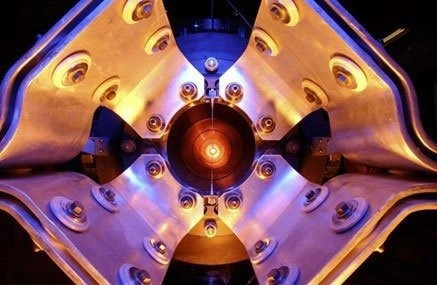The building units of atomic nuclei, protons, and neutrons comprise quarks and gluons that interact vigorously. The intense interactions make it challenging to determine the structure of protons and neutrons from theory. Scientists must instead experiment to measure it. Targets for neutrino investigations are nuclei with numerous protons and neutrons bound together.
 A magnetic focusing “horn” that scientists used to produce the neutrinos in Fermi National Accelerator Laboratory’s NuMI beam. This method made the first-ever image of the proton using neutrinos. Image Credit: Reidar Hahn, Fermi National Accelerator Laboratory.
A magnetic focusing “horn” that scientists used to produce the neutrinos in Fermi National Accelerator Laboratory’s NuMI beam. This method made the first-ever image of the proton using neutrinos. Image Credit: Reidar Hahn, Fermi National Accelerator Laboratory.
This makes it more difficult to evaluate such results and infer proton structure. Scientists have produced the first observations of this structure with neutrinos using unbound protons by scattering them from the protons that serve as the hydrogen atoms’ nuclei in the MINERvA detector.
The Impact
Scientists are constructing DUNE and other extensive neutrino experiments at the Sanford Underground Research Facility. The neutrino characteristics can be precisely measured with the aid of these experiments.
This, in turn, will explain how neutrinos impacted the universe’s structure. These experiments require an accurate understanding of the interactions between neutrinos and the heavy experiment nuclei, such as argon in the case of DUNE.
When developing a theory of those interactions, it is necessary to distinguish the consequences of nuclear binding and neutrino scattering from protons or neutrons. The findings from MINERvA will aid in developing improved models of neutrino interactions by quantifying this feature of free protons.
Summary
The main issue with the measurement revealed in this new study is that the hydrogen in MINERvA’s detector is chemically combined in plastic with carbon atoms in an even ratio. Since the carbon atom has six protons, the carbon background reaction is substantially more intense.
Researchers can distinguish the two types of reactions by using a unique method to determine the direction of the ejected neutron in the reaction, anti-muon neutrino on proton generates anti-muon and neutron.
This enables the investigation of residual backgrounds in a neutrino beam when no interaction on hydrogen atoms is conceivable. This structure measurement is interpreted as the proton’s axial vector form factor, a technical name for the structure revealed by neutrino scattering so that it can be utilized as an input to neutrino reaction predictions.
This research was supported by the Department of Energy Office of Science, Office of High Energy Physics, Messersmith Graduate Fellowships at the University of Rochester, and Graduate Research Fellowships from the National Science Foundation.
The Fermilab Accelerator Complex, which generates the NuMI neutrino beam utilized in MINERvA and other experiments, is a DOE Office of Science user facility.
Journal Reference
Cai, T., et al. (2023) Measurement of the axial vector form factor from antineutrino–proton scattering. Nature. doi:10.1038/s41586-022-05478-3